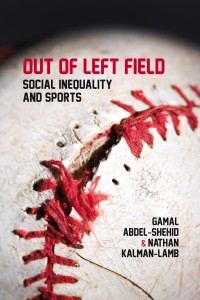Idrottsforum.org review of Out of Left Field

Out of Left Field
Social Inequality and Sport
As the television viewer and radio listener enjoyed the spectacle of the IAAF World Athletics Championships from Moscow during August 2013, all too often the commentary and extensive media comment avoided the more interesting and challenging issues of opportunity, inequality and privilege that shape high performance sport, preferring to opt for the issue of spectacle. As Debord (1994) rightly contends, it is the spectacle that serves to distract and alienate us from our fellow humans and their respective needs, a recurring theme in this stimulating new text.
Abdel Shehid and Kalman-Lamb, in their new work Out of Left Field, seek to plug this gap by reminding us that sport, like other social and cultural formations, is a site of social, economic, and racial inequalities that have to be viewed through the larger histories of patriarchy, colonialism and capitalism. Although the text’s title suggests a radical perspective, in reality the authors are more concerned with the application of existing critical social theory to sport as a means of making sense of its continuing evolution. The volume emphasises how sport can and has been used as a tool of resistance, rather than formulating a new blueprint and theoretical model that shapes our primary understanding of the role and purpose of high performance sport in contemporary society. Yet, this is no reason to minimise the efforts of the co-authors.
Designed as an introductory text for a reader familiarising him/herself with social theory, the volume has a number of declared objectives, to which it devotes roughly equal space. These include exploring the fundamental nature of sport, the impact of economic and racial inequality on sport and how this has shaped perspectives on identity and the extent to which sport shapes our ideas about the world. In terms of the four-pronged framework the authors adhere to, the most valuable and rewarding chapters focus on the first and fourth objectives.
Arguing from the perspective that inequality in sport is best understood in relation to the histories of capitalism and colonialism, and the subsequent development of racial prejudice, the authors effectively argue that the histories of colonial inequality continue to be reproduced through reduced access to education, employment and perhaps most critically of all, connections to those with power. In so doing they correctly identify a key reality that faces the great majority of the world’s population. For those brought up with the belief that sport is about finding meaning and pleasure in life, the realisation that sport is scarred by inequality often manifests itself as a major disappointment.
Throughout the fourteen chapters, Abdel Shehid and Kalman-Lamb are keen to emphasize the benefits of the socio-cultural approach to understanding elite sport, whilst advocating the importance of critical social theory and employing Marxist doctrine in providing an initial framework from which to challenge its targeted undergraduate readership.
In challenging its readers to apply the concept of “Taylorisation” to sport, chapter two suggests that the regimentation involved in elite sport results in the bodies of many athletes resembling robotic machines with the pure pleasure of performing and taking part in sport losing out to characteristics including boredom, repetition and a lack of satisfaction. Foucault refers to this development as the phenomenon of “docile bodies”. This reality eliminates chance and spontaneity from regular life in the hope of extracting peak performance from athletes executing prescribed skills with minimum error and maximum intensity. Consequently, elite athletes become passive in the decision-making process. However, by questioning their coaches (a rare phenomenon) and rejecting passive compliance, participants may retain some element of control. This scenario reinforces inequality, yet does not get in the way of the potential riches that may be earned from success in competition. Sport can and must be transformed into a reality that facilitates the on-going struggles for political and social justice.
Though it is easy to be critical of the decision to approach a limited number of theoreticians, notably Shogan (1999), Foucault (1995), Robidoux (2001), it does serve to bring the new reader into contact with concepts that they are unlikely to be familiar with. Furthermore, it offers the chance to pose critical questions that move beyond the unchallenging acceptance of what is often released by the publicity machines of governments, sport governing bodies and some broadcasting organisations.
Chapters four to eight usefully explore issues including the anti-colonial movement, racial inequality, women’s sport, and normative masculinity within the bounds of the ethos of capitalism (with especially useful references to the works of James 1963 and Galleano 1983). Yet, the focus is on providing a context for answering the author’s primary concern, namely, the increasing desire to win at all costs, and the degree to which this compromises competitors freedom. This trend encapsulates the dilemma of how to reconcile a pleasureable pastime with explicit exploitation that is intensified by the inequities of the international economic, social and political environment. In promoting the striving for greater sporting accomplishment, the outcome is often a society in which winning outweighs the importance of the game itself.
As a concept, the text is valid and much needed. However, reservations remain regarding its fluency and value to the reader unfamiliar with American sport, as the illustrations used throughout, though relevant, largely ignore other geographic regions. For an undergraduate student struggling with social theory yet keen to marry curiosity with academic inquiry, the chapters do not always successfully weave theory with practice and explanation, which the work of Jarvie (2011), Whannel (2011) and Malcolm (2013) manage more successfully.
In conclusion, the authors remind the reader once again that sport can and must be transformed into a reality that facilitates the on-going struggles for political and social justice. This is a timely call, with the issue of gender discrimination central to the successful holding and hopefully all embracing 2014 Sochi Winter Olympics and the 2022 World Cup scheduled for Qatar.
–by Russell Holden
–Nov. 2013

